Link: The Faces of Evil - Fast Facts
The following are a bunch of miscellaneous facts relating to Link: The Faces of Evil that are not noteworthy enough to get their own page. Consider this page (as well as its siblings) a crash course of useless CD-i Nintendo information!
Fact Links:
A Unique Crab Gohma -- The Cuneiform Of Gwonam's Scroll -- Cutscene Frames On The Cover Art -- Dynamic Music -- Early Game Blurb -- Early Koridai Place Names -- The Four Animators Misconception -- Ganon's Appearance in Gattu Battu -- Nintendo's Involvement In This Title -- The Post-Soviet Connection -- Promotional Poster -- Reuse and Recycle -- Unused Laser Lords Font Reusage -- Why Sidescrolling?
A Unique Crab Gohma
When you visit Anutu's hut in Link: The Faces of Evil, you can find him walking around the top floor, near his recently-caught Gohma-crab. You would think that Animation Magic would just reuse one of the Gohma enemy sprites, but they didn't. Anutu's Gohma has a unique sprite (left) when compared to a regular Gohma (right):

The Gohma-crab is one pixel shorter, has fully-closed claws as opposed to open or partially closed, and has its legs in a different shape and position. Interestingly, the Gohma-crab produces the enemy hit effect when struck with the sword, even though it isn't an enemy and should use the spark effect.
The Cuneiform Of Gwonam's Scroll
In the intro of Link: The Faces of Evil, Gwonam unravels a scroll stating that Link is the only one who can defeat Ganon. The contents of the scroll itself contain several cuneiform signs (closely matching the Neo-Assyrian form) as well as a fish-shaped symbol.
Using a cuneiform sign guide, I've converted the scroll's contents into a rough Latinized form. Check it out:
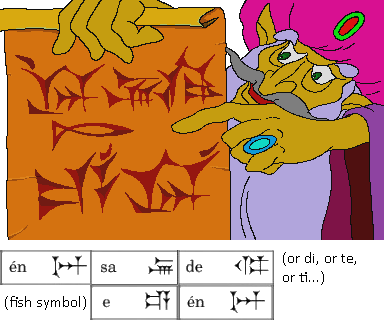
I have no idea how to actually read cuneiform nor do I know every single sign, so there's a good chance this interpretation is wrong. If anyone can verify if 1) the signs are correct and 2) what it actually means, that'd be really great! (I'd credit you on this page.)
Cutscene Frames On The Cover Art
On the box art for both Animation Magic Zelda games, several characters and bosses can be seen next to Link and Zelda. Each character's artwork corresponds to one frame in a cutscene that they star in. This implies (but does NOT confirm) that some of the original cutscene artwork was repurposed for the two games' box art. I've managed to track all of the frames down.
Here are the corresponding frames for Link: The Faces of Evil:
| Character | Origin Cutscene | Frame No. |
|---|---|---|
| Moblin | Lupay's Introduction | 
Frame 155/180 (flipped) |
| Anutu | Anutu's Crab | 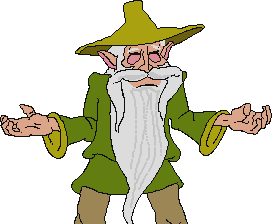
Frame 44/87 |
| Hamsha | Hamsha Freezes | 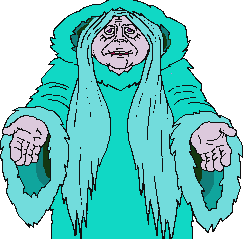
Frame 16/62 |
| Lupay | Lupay's Introduction | 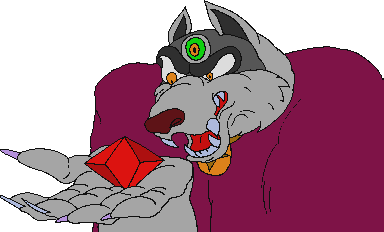
Frame 75/180 |
| Aypo | Aypo's Offer To Link | 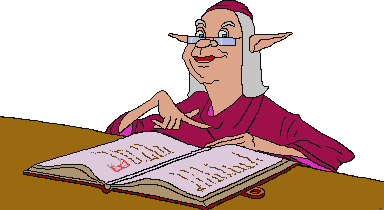
Frame 14/74 |
| Fish Lady | Fish Lady's Hint | 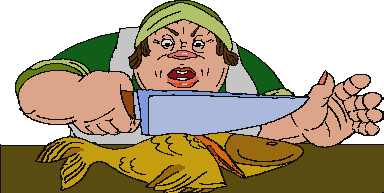
Frame 23/104 |
| Gwonam | Harlequin, Militron,
Glutko intros |
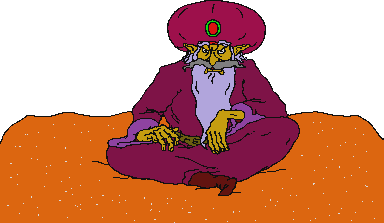
Frame 15 |
| Goronu | Goronu's Taunt | 
Frame 15/110 |
| Glutko | Glutko's Introduction | 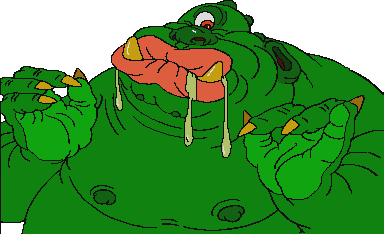
Frame 55/182 |
Dynamic Music
According to Dale DeSharone, the director of Link: The Faces of Evil and Zelda: The Wand of Gamelon, the developers wanted to put a dynamic music system into the two games. In short, the music would have changed according to the gameplay. However, the fact that the music was being streamed from the CD resulted in the idea being scrapped. This fact could explain why so much stage music stems from "base" tracks that change instruments depending on the area. Doing it that way would make the hypothetical dynamic music system sound more seamless.
This idea would not go to waste, however. A dynamic music system would be implemented into I. M. Meen and Chill Manor, with the music changing whenever a enemy attacks the player.
Early Game Blurb
Packaged with early CD-i titles was a catalog that contained a list of released and upcoming titles for the system. This catalog was updated a few times, and appears to have stopped being used around 1993 or 1994. A specific late 1992 catalog (packaged with Laser Lords and likely several other titles) had early (and mistake-filled) plot descriptions for four of the CD-i Nintendo titles. This includes The Faces of Evil, The Wand of Gamelon, Hotel Mario, and Super Mario's Wacky Worlds - unfortunately, none of the other titles got a mention.
This is the blurb for Link: The Faces of Evil:
LINK: THE FACES OF EVIL There's big trouble in the Kingdom of Hyrule.
Ganon, the Lord of Darkness, and his evil enemy forces have captured the gentle giant,
Kuluan. Ride the magic carpet to defeat the six evil faces.
It's a very interesting description, mainly because it doesn't mention Koridai at all and, instead, focuses on Ganon's capturing of Kuluan (likely Kulvan the blacksmith). Perhaps Koridai is part of Hyrule, or the blurb is badly-written. What's more interesting is how it describes Kul(u/v)an as a gentle giant.
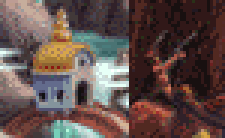
In the overworld map of Link: The Faces of Evil, Kulvan is shown to be quite huge - about the size of Morshu's store - and no other characters are shown on the world map of this game or TWoG. Furthermore, the game has quite a bit of imagery relating to giants. There are huge skulls in Ganon's Lair and two giant bosses - Glutko and Militron, the latter of which is just a regular guy wearing a massive suit of armor. Or maybe he's a giant wearing a suit of armor.
Pretty interesting!
(This blurb would also appear in Electronics Boutique's Christmas 1993 catalog.)
Early Koridai Place Names

In May of 2010, several pieces of artwork relating to Animation Magic's Zelda games were posted online on the Hardcore Gaming 101 blog, shared by the games' late director Dale DeSharone. These included early overworld map drawings of Koridai and Gamelon, as well as two painted thumbnails of one of their areas.
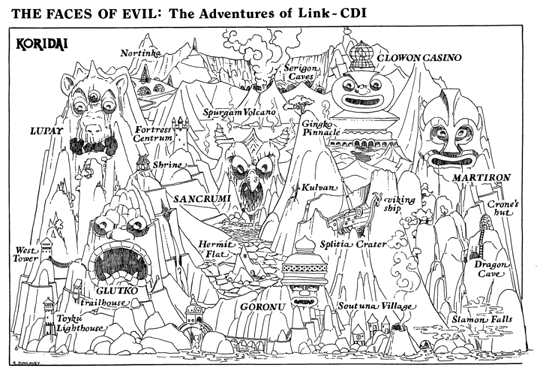
The Koridai map is much more interesting as it contains multiple design differences from the final map - you can see them in the comparison above - but it also has early names for around half of Koridai's locations, as well as names for minor locations that aren't named in-game. These early place names include:
| Location | Early Name |
|---|---|
| Crater Cove | Soutuna Village |
| Firestone Lake | Spurgam Volcano |
| Ganon's Lair | Sancrumi |
| Harlequin Bazaar | Clowon Casino |
| Militron | Martiron |
| Shipwreck Cliff | Splitia Crater |
| Spearfish Falls | Slamon Falls |
Lotta place names starting with S in the early map. It's interesting that a couple of the bosses, being Militron (Martiron) and potentially Harlequin (Clowon), had different names earlier in development. Makes you wonder if there were cut names for the other bosses too. (Apart from Ganon, obviously.)
The Four Animators Misconception
One of the most prevalent facts about the CD-i Nintendo games (apart from Nintendo having no involvement in their development) is how Animation Magic had a team of four Russian animators working in an apartment for six months to create the cutscenes for their Zelda titles. This is only a partial truth - the timeframe is correct, the apartment is a half-truth, and the team of four is false. Here's why:
- Firstly, the credits for both Link: The Faces of Evil and Zelda: The Wand of Gamelon have 25 animators listed, and that's not including technicians or camera operators. So it wasn't just a team of four. Given the scenario and following facts, it's more likely that they initially hired six animators and brought them to the USA, with the rest working in Animation Magic's Saint Petersburg subsidary.
- Secondly, the source of this fact - an interview with game director Dale DeSharone - mentions that they found six 2D animators in Saint Petersburg to work on their project, and brought them over to that apartment workspace. (Also, Dale says that they were working in a couple of apartments, and not just one.) This is also mentioned in an interview with Denis Chernov, one of the games' animators.
- Another interesting thing is that Dale does mention four artists as part of Animation Magic in that interview, and there are four artists in the credits of both games - those being the two background painters and two sprite artists. However, he notes that were done at Animation Magic's Cambridge office, and were not done by the team from Russia. (As a matter of fact, it seems they hadn't been hired yet!)
I think that this artists fact was confused at some point with the animators one, and nobody bothered to actually fact-check it.
So, a more accurate version of the fact would be that Animation Magic initially brought over six animators from Russia to have them work in a couple of apartments for six months, and then later hired nineteen more animators to work solely in Russia as the company grew. But that's more clunky and doesn't invoke the "LOL THE CD-I GAMES WERE BADLY MADE AND RUSHED!!!!!!1" tones as much as the incorrect version.
Hm.
Ganon's Appearance in Gattu Battu
This is more of a reference than anything, but I find it so funny and odd that it deserves a spot here.

There's a painting of what is very clearly CD-i Ganon doing his "DIE" face in the Indian cartoon Gattu Battu. It appears in Season 1 Episode 21, "Ghost In The Hotel", and is part of a gag around the 8:15 mark where Battu gets scared of the paintings in a hallway. (Yes, it's in an episode about a hotel. Go figure!)
The CD-i Nintendo community doesn't know why or how this happened, and it's likely we never will.
Nintendo's Involvement In This Title
A fact often stated about the CD-i Nintendo games is that Nintendo themselves had little to no involvement in their creation, and that the developers were more or less given free reign to do weird things with the franchises. There also happen to be interviews with people who worked on the four released titles (plus an unreleased one), with at least one of the questions focusing on Nintendo's involvement. So I wonder... for this game, how true is that statement?
For Link: The Faces of Evil: We have an interview with the game's late director, Dale DeSharone. In it, he confirms that Nintendo approved the two titles' design documents and their character sketches - specifically focusing on how Link and Zelda looked - and that was about it. It appears that the fact is true, at least for this game.
The Post-Soviet Connection
Let's lay down some facts about the origins of Animation Magic and the political climate back in the early 90s:
- The Soviet Union dissolved on December 26th, 1991, ending the Cold War between it and the United States. As a result, companies were more willing to work in both countries at the same time.
- An interview in the book Hammer and Silicon: The Soviet Diaspora in the US Innovation Economy confirms that Animation Magic was founded in 1991, with their Russian subsidary founded in 1992. No specific months/days were listed.
- The earliest date associated with the Animation Magic Zelda games is April 1992. This is the date listed on the finalized overworld map sketches of Koridai and Gamelon. It's likely development started before April as there are earlier concept drawings of the overworld maps, though this is currently unconfirmed.
This gives us a roughly four month time period between the dissolution of the Soviet Union and Animation Magic starting work on their Zelda titles (and likely hiring their Russian animators). This would make Animation Magic one of the first post-Cold War US companies to outsource to Russia, if not the first. However, it's hard to say for sure without more specific dates as well as analysis of other companies that worked with immediately-post-Soviet Union Russia.
Promotional Poster
To promote the Animation Magic Zelda games, Philips had promotional posters made for them. They feature the box artwork of Link and Zelda in the highest quality they've ever been, as well as some neat-looking border graphics and some promotional text. It's likely that other promotional posters were made for certain CD-i titles (maybe Hotel Mario or Burn:Cycle), but these are the only two that I've been able to confirm.
These posters were unheard of until 2019, when an eBay seller listed one of each poster for about $40 plus $20 shipping. The seller's family owned printing companies in Tennessee that worked with Philips and Magnavox, and was also selling some posters relating to the Odyssey console series. It's very likely that these are the only copies of the posters left in existence. I wish I had the money to buy one of them! :(
Here is the promo poster for Link: The Faces of Evil:
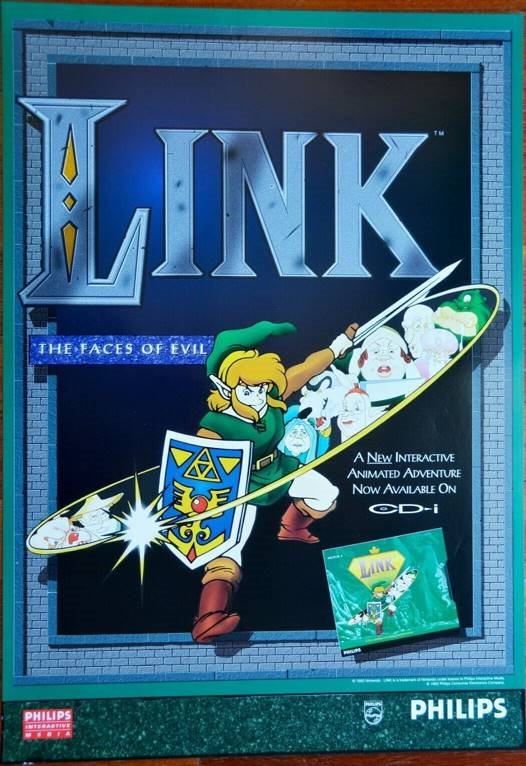
Reuse and Recycle
Animation is hard work, and it often leads to shortcuts such as reusing frames in one scene for another. The CD-i Nintendo games were made on a budget and time limit, so it comes as no surprise that they recycle frames between cutscenes. Let's learn about some examples, shall we?
(Instances of frame reuse in the same cutscene and shortened/identical cutscene variants will not be counted. We're reusing frames across 2+ different cutscenes here.)
For Link: The Faces of Evil:
- Many of Gwonam's cutscenes start with one of two animations, which vary in length between each scene. Here they are in their longest forms; the first is from Glutko's introduction, while the second is from Lupay's introduction.
- Both fairy cutscenes use the exact same animation - only the audio is different.
- The end frame of the Power Glove cutscene and the first frame of the intro are very clearly based on the same drawing, but have enough differences to NOT be the same drawing. Here's a comparison - I flipped the Power Glove frame to have it face the same direction as the intro frame:
- The end frame of Harlequin's rematch cutscene in Lupay is almost identical to a frame during his "taunt" cutscene in Harlequin Bazaar. There's a single coloring difference:
- The animation of Ganon being sucked into the Book of Koridai was reused for Zelda: The Wand of Gamelon.
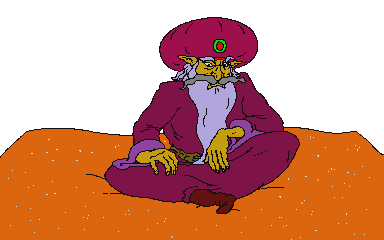
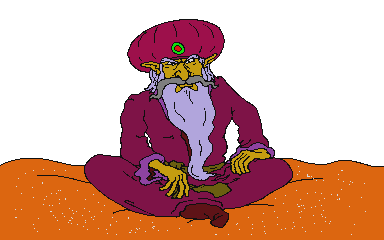
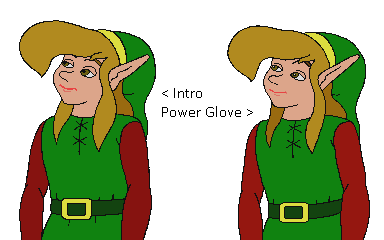
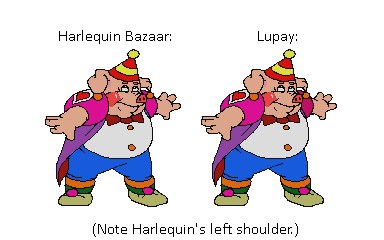
Unused Laser Lords Font Reusage
Initially, the CD-i game Laser Lords was going to be released on the PC under the name StarTribes: Myth of the Dragon Lord. Several screenshots were released to the BBSes of the day, but ultimately it got sent over to the CD-i realm during Spinnaker Software's twilight years. These screenshots were preserved on the GIFs Galore CD-ROM by Walnut Creek CDROM, and were forgotten about until a Twitter bot shared them and someone recognized them. You can read more about this fun tidbit here.
So what does this bit of trivia have to do with CD-i Zelda? Well, there were two more images of StarTribes on the disc that weren't picked up by the discoverers of that find, and both of them show proper gameplay. Here they are:
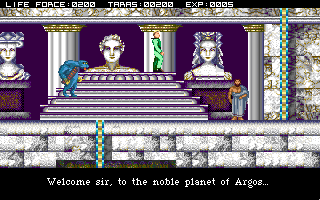

(I'm posting both of them here as I plan to expand this site to cover CD-i Zelda-adjacent titles, such as I.M. Meen, Pyramid Adventures and, well, Laser Lords. One day...)
Notice anything... familiar about the font on the Planet Luxor image? That's because it's using an earlier version of the menu font from Animation Magic's Zelda titles! This makes a lot of sense when you consider that Animation Magic was made up of ex-Spinnaker employees, specifically from their CD-i team. They likely decided to reuse assets they already had.
Here's a comparison of the two:

The difference lies within the capital letters - the S is a lot rougher-looking while the L is missing a single pixel near the top-left. From my lone playthrough of Laser Lords, I can safely say that this font was never used in that game.
Why Sidescrolling?
So... why did Animation Magic decide to make their Zelda games side-scrollers, apart from being inspired by Zelda II? Well, in this interview with the games' late director, Dale DeSharone, it was a decision made by Animation Magic to appeal to Philips, as they were more concerned about their titles having stronger graphics that were distinct from other game consoles' output than gameplay.
(It seems that certain game companies nowadays are following in Philips' footsteps LUL)
Return to top
Last updated: August 13th, 2025.